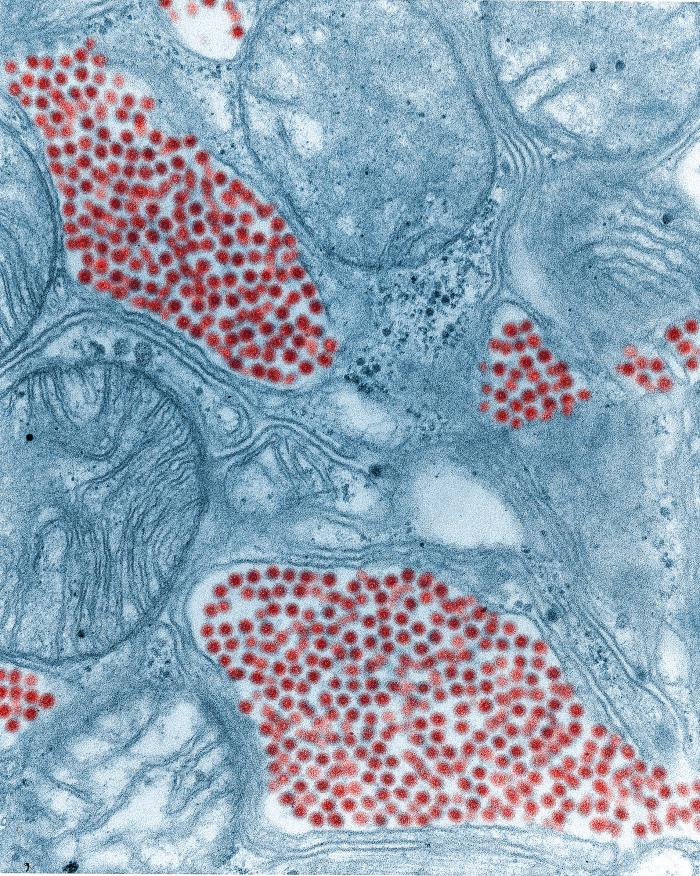- Eastern equine encephalitis virus
Taxobox | color=violet
name = "Eastern equine encephalomyelitis "

caption =
colourised TEMmicrograph of amosquito salivary gland . The red dots are coloured red. (83,900x magnification)
virus_group = iv
familia = "Togaviridae "
genus = "Alphavirus "
species = "Eastern equine encephalitis virus"Eastern equine encephalomyelitis virus (EEE), commonly called sleeping sickness or "Triple E", is a zoonotic
alphavirus andarbovirus present in North, Central and South America and the Caribbean. EEE was first recognised inMassachusetts ,USA in 1831 when 75horse s died of encephalitic illness. Epizootics in horses have continued to occur regularly in the United States. EEE is found today in the eastern part of the country and is often associated with coastal plains.The causal agent, EEE, was first isolated from infected horse brains in 1933. In 1938, the first confirmed human cases were identified when thirty children died of encephalitis in northeastern USA. These cases coincided with outbreaks in horses in the same regions. The fatality rate in humans is 35% and there is currently no cure for human infections.
EEE is capable of infecting a wide range of animals including mammals, birds, reptiles and amphibians. The virus is maintained in nature through a
bird -mosquito cycle. There are two mosquito species primarily involved in this portion of the cycle, they are "Culiseta melanura" and "Cs. morsitans". These mosquitoes feed on the blood of birds. The amount of virus found in nature increases throughout the summer as more birds and more mosquitoes become infected. Transmission of EEEV to mammals occurs via other mosquitoes. These other mosquitoes are called bridge vectors because they bring the virus from avian populations to mammalian populations. They include " Coquiletidia perturbans, Aedes vexans, Ochlerotatus sollicitans " and "Oc. canadensis". All these mosquitoes are primarily mammalian feeders. Generally, people only become sick through the bite of an infected mosquito. Humans, horses and other infected mammals do not circulate enough virus in their blood to infect additional mosquitoes. There have been some cases where EEEV has been contracted through lab exposures or from exposure of the eyes, lungs or skin wounds to brain or spinal cord matter from infected animals.Symptoms in horses occur 1-3 weeks after infection and begin with a fever that may reach as high as 106 degrees fahrenheit (41 degrees Celsius). The fever usually lasts for 24-48 hours. Nervous signs appear during the fever that include sensitivity to sound, periods of excitement, and restlessness. Brain lesions appear causing drowsiness, drooping ears, circling, and abnormal gait. Paralysis follows causing the horse to have difficulty raising its head. The horse usually suffers complete paralysis and death 2-4 days after symptoms appear. Mortality rates among horses with the eastern strain range from 70 to 90%.
The disease can be prevented in horses with the use of
vaccination s. These vaccinations are usually given together with vaccinations for other diseases, most commonly WEE, VEE, andtetanus . Most vaccinations for EEE consist of the killed virus.Several states in the northeast US have seen increased virus activity since 2004. Between 2004 and 2006 there were at least 10 human cases of EEE reported in Massachusetts. In 2006, approximately convert|500000|acre|km2 in southeastern Massachusetts were treated with mosquito adulticides to reduce the risk of humans contracting EEE. There have been several human cases reported in New Hampshire as well. [http://www.boston.com/news/local/massachusetts/articles/2006/08/18/mosquito_borne_virus_infects_2d_in_mass/] [http://www.boston.com/news/globe/city_region/breaking_news/2006/08/middleborough_b.html]
In October 2007 a citizen of
Livingston, West Lothian ,Scotland became the first European victim of this disease. The man had visited New Hampshire during the summer of 2007 on a fishing vacation and was diagnosed as having EEEV on 13th September 2007. He fell ill with the disease on 31st August 2007 just one day after flying home. [http://news.bbc.co.uk/1/hi/scotland/edinburgh_and_east/7033203.stm]EEEV is closely related to
Venezuelan equine encephalitis virus andWestern equine encephalitis virus .References
*Recent case of Triple E, causing (possibly permanent) coma [http://news.bbc.co.uk/2/hi/uk_news/scotland/edinburgh_and_east/7033203.stm]
*The CDC web page with more complete information: [http://www.cdc.gov/ncidod/dvbid/arbor/eeefact.htm]
*Source for a portion of this information: Evans, Borton, Hintz, Van Vleck. "The Horse". 1977. W.H. Freeman and Company. New York.another trace of EEEVsee link below:
http://www.seacoastonline.com/articles/20081010-NEWS-81010036
Wikimedia Foundation. 2010.
